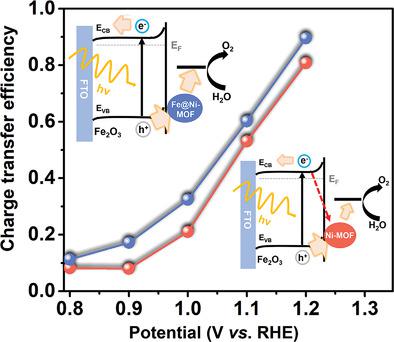Our official English website, www.x-mol.net, welcomes your feedback! (Note: you will need to create a separate account there.)
Modulating Charge Transfer Efficiency of Hematite Photoanode with Hybrid Dual‐Metal–Organic Frameworks for Boosting Photoelectrochemical Water Oxidation
Advanced Science ( IF 15.1 ) Pub Date : 2020-10-25 , DOI: 10.1002/advs.202002563 Keke Wang 1 , Yang Liu 1 , Kenta Kawashima 2 , Xuetao Yang 1 , Xiang Yin 1 , Faqi Zhan 1 , Min Liu 3 , Xiaoqing Qiu 1 , Wenzhang Li 1, 4 , Charles Buddie Mullins 2 , Jie Li 1
Advanced Science ( IF 15.1 ) Pub Date : 2020-10-25 , DOI: 10.1002/advs.202002563 Keke Wang 1 , Yang Liu 1 , Kenta Kawashima 2 , Xuetao Yang 1 , Xiang Yin 1 , Faqi Zhan 1 , Min Liu 3 , Xiaoqing Qiu 1 , Wenzhang Li 1, 4 , Charles Buddie Mullins 2 , Jie Li 1
Affiliation

|
The glorious charge transfer efficiency of photoanode is an important factor for efficient photoelectrochemical (PEC) water oxidation. However, it is often limited by slow kinetics of oxygen evolution reaction. Herein, a dual transition metal‐based metal–organic frameworks (MOF) cocatalyst, Fe@Ni–MOF, is introduced into a titanium‐doped hematite (Fe2O3:Ti) photoanode. The combination of Ni and Fe can optimize the filling of 3d orbitals. Moreover, the introduction of Fe donates electrons to Ni in the MOF structure, thus, suppressing the irreversible (long‐life‐time) oxidation of Ni2+ into Ni3+. The resulting Fe@Ni–MOF/Fe2O3:Ti photoanode exhibits ∼threefold enhancement in the photocurrent density at 1.23 V versus the reversible hydrogen electrode. Kinetic analysis of the PEC water oxidation processes indicates that this performance improvement is primarily due to modulating the charge transfer efficiency of hematite photoanode. Further results show that a single transition metal‐based MOF cocatalyst, Ni–MOF, exhibits slow charge transfer in spite of a reduction in surface charge recombination, resulting in a smaller charge transfer efficiency. These findings provide new insights for the development of photoelectrodes decorated with MOFs.
中文翻译:

用混合双金属有机框架调节赤铁矿光电阳极的电荷转移效率以促进光电化学水氧化
光阳极出色的电荷转移效率是高效光电化学(PEC)水氧化的重要因素。然而,它常常受到析氧反应动力学缓慢的限制。在此,将双过渡金属基金属有机框架(MOF)助催化剂Fe@Ni-MOF引入钛掺杂赤铁矿(Fe 2 O 3 :Ti)光阳极中。Ni和Fe的组合可以优化3d轨道的填充。此外,Fe的引入将电子提供给MOF结构中的Ni,从而抑制了Ni 2+不可逆(长寿命)氧化为Ni 3+。与可逆氢电极相比,所得的 Fe@Ni–MOF/Fe 2 O 3 :Ti 光阳极在 1.23 V 下的光电流密度提高了约三倍。PEC 水氧化过程的动力学分析表明,这种性能改进主要是由于调节赤铁矿光电阳极的电荷转移效率。进一步的结果表明,尽管表面电荷复合减少,但单一过渡金属基 MOF 助催化剂 Ni-MOF 仍表现出缓慢的电荷转移,导致电荷转移效率较低。这些发现为MOFs修饰的光电极的开发提供了新的见解。
更新日期:2020-12-03
中文翻译:

用混合双金属有机框架调节赤铁矿光电阳极的电荷转移效率以促进光电化学水氧化
光阳极出色的电荷转移效率是高效光电化学(PEC)水氧化的重要因素。然而,它常常受到析氧反应动力学缓慢的限制。在此,将双过渡金属基金属有机框架(MOF)助催化剂Fe@Ni-MOF引入钛掺杂赤铁矿(Fe 2 O 3 :Ti)光阳极中。Ni和Fe的组合可以优化3d轨道的填充。此外,Fe的引入将电子提供给MOF结构中的Ni,从而抑制了Ni 2+不可逆(长寿命)氧化为Ni 3+。与可逆氢电极相比,所得的 Fe@Ni–MOF/Fe 2 O 3 :Ti 光阳极在 1.23 V 下的光电流密度提高了约三倍。PEC 水氧化过程的动力学分析表明,这种性能改进主要是由于调节赤铁矿光电阳极的电荷转移效率。进一步的结果表明,尽管表面电荷复合减少,但单一过渡金属基 MOF 助催化剂 Ni-MOF 仍表现出缓慢的电荷转移,导致电荷转移效率较低。这些发现为MOFs修饰的光电极的开发提供了新的见解。



























 京公网安备 11010802027423号
京公网安备 11010802027423号